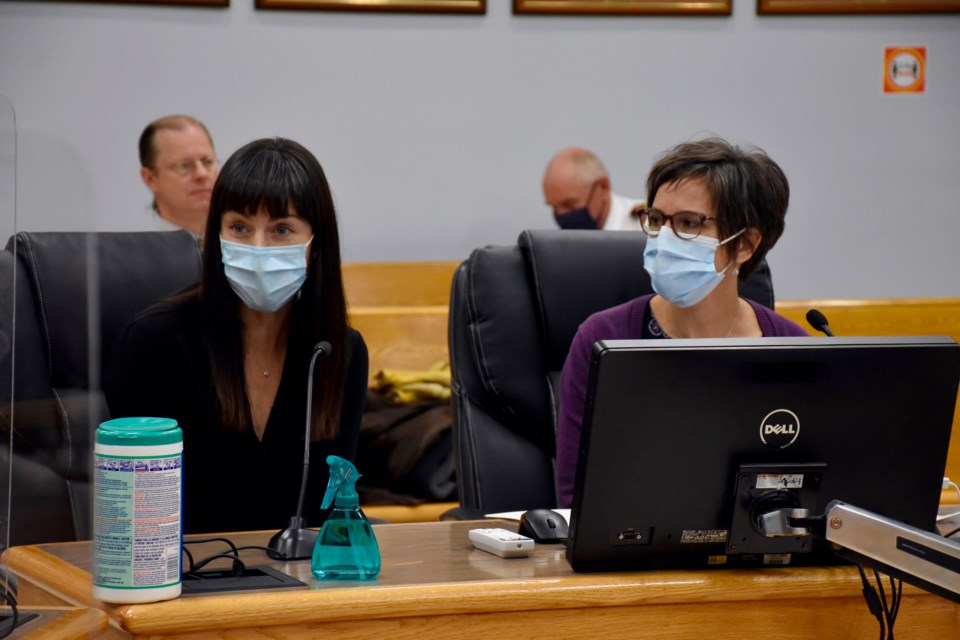In a wooded area somewhere in Timmins, birch trees lean up against each other. A safety container with needles hangs from one of the branches.
“This is an area where obviously patients — clients I should say — are IV drug using," Dr. Julie Samson told Timmins council this week. "...this is going on in our town. This is sad that this is going on and we’re not helping them."
In a presentation lasting about 40 minutes, Samson and Dr. Louisa Marion-Bellemare talked to council about treatment of addictions in the city. They talked about the staggeringly high rate of overdose deaths in the city, and shared their vision on how to address it.
The immediate short-term solutions they suggested is medically-supported acute withdrawal community treatment in the city, access to medically-supervised safe beds, and an overdose prevention site.
Their vision is an umbrella approach.
It's a model, explained Marion-Bellemare, that has one group working together with all community partners "so that everything flows together and access is so much easier for the patient instead of us all working in silos like we are today."
In 2019 there were 20 overdose-related deaths in Timmins. From January to May this year, there were 17 confirmed and probable overdose deaths. The presentation cites the numbers being from the Chief Coroner Office of Ontario, and Public Health Ontario, respectively.
Working in the emergency department at Timmins and District Hospital, Samson said they know the 2020 number will be much higher this year.
In 2019, Timmins' overdose-related death rate was 46.8 per 100,000 people. The Ontario rate for the same year was 11.2.
“We are doing the worst in terms of death rates in Ontario and I can even argue possibly nationally, and this is just in Timmins, not even Timmins and area. We also know we have a lot of issues with homelessness in Timmins. I am not saying by far that every homeless person has addiction. Addiction affects all socialeconomic status, but if you have homelessness you are at risk of more addictions. So you can’t solve one without solving the other, they are hand-in-hand. If you give people addiction treatment, they are moreso to get income, stable housing, employment and homelessness goes down,” she said.
This year, Samson said there has been zero access to safe beds in Timmins. The nearest detox centre is in Smooth Rock Falls.
In the absence of these services, Samson said patients are showing up at the emergency department.
“We have a very high rate of admissions due to addictions in our mental health unit. The average in the province is 28 per cent, we’re sitting at 65 per cent. We are, in essence, working as a detox centre in our mental health unit as opposed to taking care of patients with mental health illnesses such as schizophrenia, depression, anxiety,” she said.
As the types of drugs people are using change, so does the treatment, according to the doctors.
“Addiction issues are changing, that’s what we need to realize. It’s no longer percocets and oxys from the 2010s, we’re talking about fentanyl, heroin, carfentanyl, tons of IV drug use," said Samson.
There are national practice guidelines for opiate use disorder.
“Most communities are following these provincial and national guidelines and in Timmins we’re not there yet, but our hope is that we get there and we’re going to work on this,” Marion-Bellemare said.
For opiate agonist treatment (OAT), she said the first-line treatment option should be suboxone (buprenorphine/Naloxone). Methadone should be the second-line treatment option.
“It’s of utmost importance that we treat these people according to these guidelines. When we have people come into our practice with other illnesses such as any cancer diagnosis or diabetes, we treat them according to clinical practice guidelines. Of course there’s always outliers, there’s some people that don’t fall perfectly into these practice guidelines and we have to make other clinical decisions, but we know that the majority of people when it comes to treatment for most medical conditions, most of us fall within the same area for treatment,” she said.
For harm reduction, Samson said they're working on educating hospital staff.
Both doctors acknowledged people are entitled to their opinion about overdose prevention sites — legally-sanctioned, supervised facility allowing people to consume pre-obtained drugs in an anxiety-free atmosphere, under hygienic and low-risk conditions.
“Overdose prevention sites has been shown to save lives, and I think that’s what we want here. We want to save lives. Our death rates are huge here and this could make a difference,” Samson said.
Funding for the initiatives would be required from upper levels of government. Marion-Bellemare said the goals laid out are hers and Samson's dreams, and what they think would be best for patients right now.
For now, she said the most important thing to address locally is the stigma in the community.
“We always hope when we present true evidence to people and back ourselves up in what we say that the ignorance goes away and we can change people’s minds," she said.
Timmins Mayor George Pirie said the doctors' presentation gives him hope things will get better.
"We have the moral authority to end the apathy in this community. This is what this council can do,” he said, noting council doesn't have authority over the funding.
Last week, Northern Ontario's Large Urban Mayors (NOLUM) met. The only item they got to on their meeting agenda was homelessness, addictions and mental health. The group is sending a letter to the province and federal government asking for support and a meeting to address mental health and addiction in the north.
Read the doctors' full presentation to council here,



